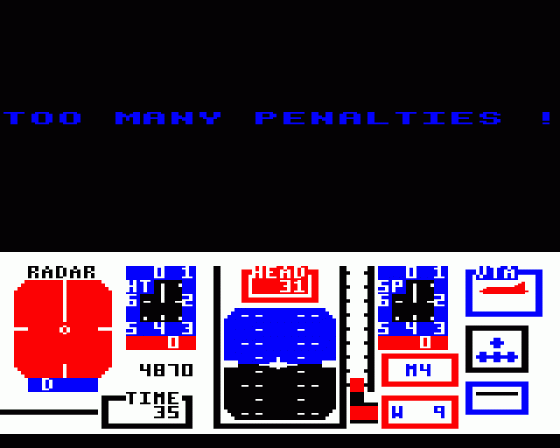
Home Computing Weekly
 4th June 1985
4th June 1985
Categories: Review: Software
Author: E.D.
Publisher: Anirog
Machine: BBC Model B
Published in Home Computing Weekly #115
Combat and flight simulators seem to be in vogue these days. Following Dambusters and Spitfire '40 from US Gold and Mirrorsoft, Jump Jet brings us right up to date with modern flight and warfare techniques.
A vast improvement over Anirog's much earlier flight simulator Flight Path 737, this program puts you behind the controls of a Sea Harrier VTOL. After reading the clearly written instruction manual, the simulator itself is not as daunting as it may at first appear.
Vertical take-off and landing is achieved simply by changing the angle of the plane's jet nozzles to vertical, after ensuring the flaps are down. Taking the engines up to full power causes the jet to rise. The screen at this point shows an aerial view of an aircraft carrier deck above a simplified representation of a Harrier's console. As the plane rises, the shadow of the jet shrinks on the deck until the screen splits to give a head-on and sidelong view of the carrier with the jet above.

Reducing power at this point allows you to hover over the carrier. Pulling back or pushing the joystick causes the plane's nose to rise or fall and the jet creeps forwards or backwards accordingly. Increasing the height above 50 feet causes the screen to change to a conventional view from the cockpit complete with moving clouds and waves.
Forward motion is achieved by angling the nozzles at 45 degrees. When sufficient forward momentum is achieved, the flaps and undercarriage are raised and the nozzles adjusted to their horizontal position for normal jet flight.
The console shows all the necessary instruments for fuel, height, speed and power. Additionally, undercarriage, flap and nozzle positions are graphically displayed at the right of the panel, whilst the artificial horizon is at the centre. On the left of the panel is a radar display which shows the location of the carrier and enemy planes, and it can also calculate their range.

By far the most rewarding aspect of this simulator is the ability to choose a target, navigate to intercept and destroy and then to return to the carrier or engage another plane if enough fuel remains. Sounds easy but just try it!
Landing is particularly difficult especially if one of the higher levels of play are chosen. The five levels range from Practice on a calm day to Group Captain in a storm with mountainous seas. The level chosen also determines the number of errors which will be tolerated before resulting in a crash.
The only criticism I have of this game is purely a cosmetic one relating to the console which looks a little overcrowded because of the size of the lettering. Otherwise the graphics are quite good, I especially liked the increase in speed of the clouds and the waves in sympathy with the Harrier's speed.
Although Anirog has used its Voicemaster interface to add speech to the program, the quality of synthesis is deliberately low, but clear, to simulate the pilot's intercom. The voice is totally software driven and will- work on any 64.
All in all, this program is a jump in the right direction for Anirog.



